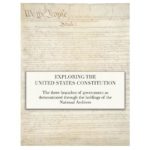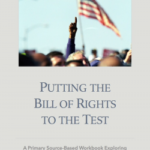In this lesson, students will look at the various dimensions of right to counsel. They will study how the meaning of this right has evolved over time with reference to specific landmark United States Supreme Court cases. Students will develop lists of reasons why such a right is important to the functioning of the adversary process. The lesson ends with an examination of the role of the criminal attorney.
Your Right to Remain Silent: Miranda v. Arizona
In 1966, the Supreme Court’s 5-4 ruling in Miranda v. Arizona dramatically changed criminal procedures. The Court linked the Fifth Amendment’s privilege against self-incrimination to the Sixth Amendment’s guarantee of a right to counsel and applied both to protect a suspect’s rights from arrest through trial. This lesson plan is based on the Annenberg Classroom video “The Right to Remain Silent: Miranda v. Arizona.”
Sixth Amendment Activities
Apply landmark Supreme Court cases to contemporary scenarios related to your right to counsel and your right to a fair trial in the Sixth Amendment.
Gideon v. Wainwright (1963) Middle School Level

Does the Sixth Amendment’s right to counsel in criminal cases extend to defendants in state courts, even in cases in which the death penalty is not at issue? High school level also available.
This case summary provides teachers with everything they need to teach about Gideon v. Wainwright (1963). It contains background information in the form of summaries and important vocabulary at three different reading levels, as well a review of relevant legal concepts, diagram of how the case moved through the court system, and summary of the decision. This resource also includes nine classroom-ready activities that teach about the case using interactive methods.
Exploring the United States Constitution eBook

Each chapter connects one or more of the billions of primary source documents in the holdings of the National Archives to the principles found in the United States Constitution. These documents exemplify the workings of the three branches of the federal government as laid out in our Constitution. This eBook is available as a Multi-Touch book for iPad and Mac on iTunes, or for PC, Android devices, Mac, iPhone, iPad, or eReader with Scribd.
Annenberg Classroom’s That’s Your Right

This fun online card game teaches middle and high school students about their rights under the Bill of Rights, the first ten amendments to the Constitution. The game offers three skill levels as a player tries to match a right with scenario. Founder cards grant players special abilities that give them an advantage in game play.
Alabama v. Shelton (2002)
Does the Sixth Amendment right to appointed counsel apply to a defendant who was sentenced to a suspended sentence? This case summary shows how the Supreme Court answered that question in 2002.
Miranda v. Arizona (1966)

This case summary provides teachers with everything they need to teach about Miranda v. Arizona (1966). It contains background information in the form of summaries and important vocabulary at three different reading levels, as well a review of relevant legal concepts, diagram of how the case moved through the court system, and summary of the decision. This resource also includes ten classroom-ready activities that teach about the case using interactive methods.
Constitutional Index – Amendment 6 Assistance of Counsel Clause
The Constitutional Index breaks down the U.S. Constitution by Section, Amendment, and Clause and contains broader topics and themes. These are used to cross-reference Library resources in an effort to annotate constitutional history.
Putting the Bill of Rights to the Test

This primary source-based workbook (as PDF or eBook/ePub) helps students explore some of the protections found in the Bill of Rights and how they’ve been tested throughout U.S. history. Each chapter includes background information, guiding questions, analysis questions, primary sources, and discussion questions. Concepts include freedom of religion, speech and press; the right to assemble, petition, bear arms, and have counsel; search and seizure; due process; and cruel and unusual punishment.